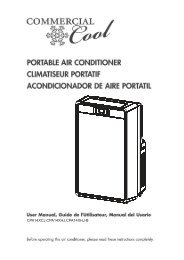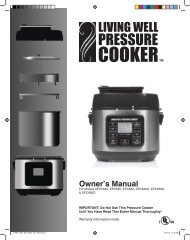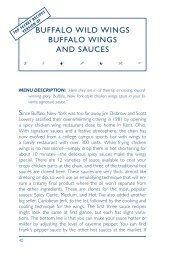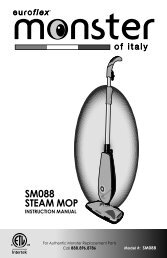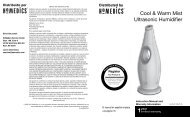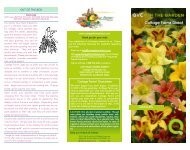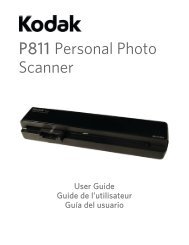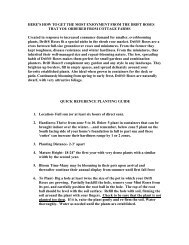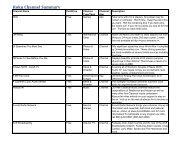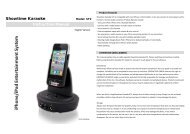BOWL-LIFT STAND MIXER BATTEUR À BOL AMOVIBLE ... - QVC.com
BOWL-LIFT STAND MIXER BATTEUR À BOL AMOVIBLE ... - QVC.com
BOWL-LIFT STAND MIXER BATTEUR À BOL AMOVIBLE ... - QVC.com
You also want an ePaper? Increase the reach of your titles
YUMPU automatically turns print PDFs into web optimized ePapers that Google loves.
Making bread with a mixer is quite different from making bread by hand.<br />
Therefore, it will take some practice before you are <strong>com</strong>pletely <strong>com</strong>fortable<br />
with the new process. For your convenience, we offer these tips to help you<br />
be<strong>com</strong>e accustomed to bread making the KitchenAid ® brand way.<br />
• Start out with an easy recipe, like<br />
Basic White Bread, page 29, until<br />
you are familiar with using the<br />
dough hook.<br />
• ALWAYS use the dough hook to<br />
mix and knead yeast doughs.<br />
• Use Speed 2 to mix or knead yeast<br />
doughs. Use of any other speed<br />
creates high potential for Stand<br />
Mixer failure.<br />
• NEVER use recipes calling for more<br />
than 14 cups (3.4 L) all-purpose<br />
flour or 8 cups (1.9 L) whole wheat<br />
flour when making dough with a<br />
6 quart (5.7 L) mixer.<br />
• NEVER use recipes calling for more<br />
than 12 cups (3 L) all-purpose flour<br />
or 6 cups (1.5 L) whole wheat flour<br />
when making dough with a 5 quart<br />
(4.73 L) mixer.<br />
• Use a candy or other kitchen<br />
thermometer to assure that liquids<br />
are at temperature specified<br />
in the recipe. Liquids at higher<br />
temperature can kill yeast, while<br />
liquids at lower temperatures will<br />
retard yeast growth.<br />
• Warm all ingredients to room<br />
temperature to insure proper rising<br />
of dough. If yeast is to be dissolved<br />
in bowl, always warm bowl first by<br />
rinsing with warm water to prevent<br />
cooling of liquids.<br />
• Allow bread to rise in a warm<br />
place, 80°F to 85°F (26°C to 29°C),<br />
free from draft, unless otherwise<br />
specified in recipe.<br />
• Here are some alternative rising<br />
methods to use: (1) The bowl<br />
BREAD MAKING TIPS<br />
containing the dough can be<br />
placed on a wire rack over a pan<br />
of hot water. (2) The bowl can<br />
be placed on the top rack of an<br />
unheated oven; put a pan of hot<br />
water on the rack below. (3) Turn<br />
the oven to 400°F (200°C) for<br />
1 minute; then turn it off; place<br />
the bowl on the center rack of the<br />
oven and close the door.<br />
• Cover bowl with waxed paper, if<br />
desired. Always cover with towel<br />
to retain warmth in the bowl and<br />
protect the dough from drafts.<br />
• Recipe rising times may vary due<br />
to temperature and humidity in<br />
your kitchen. Dough has doubled<br />
in bulk when indentation remains<br />
after tips of fingers are pressed<br />
lightly and quickly into dough.<br />
• Most bread recipes give a range<br />
for the amount of flour to be used.<br />
Enough flour has been added<br />
when the dough starts to clean<br />
sides of bowl. If dough is sticky or<br />
humidity is high, slowly add more<br />
flour, about 1 ⁄2 cup (120 ml)<br />
at a time but NEVER exceed<br />
re<strong>com</strong>mended flour capacity.<br />
Knead after each addition until<br />
flour is <strong>com</strong>pletely worked into<br />
dough. If too much flour is added,<br />
a dry loaf will result.<br />
• When done, yeast breads and rolls<br />
should be deep golden brown in<br />
color. Other tests for doneness of<br />
breads are: Bread pulls away from<br />
the sides of pan, and tapping<br />
on the top of the loaf produces<br />
a hollow sound. Turn loaves and<br />
rolls onto racks immediately after<br />
baking to prevent sogginess.<br />
ENGLISH<br />
27




